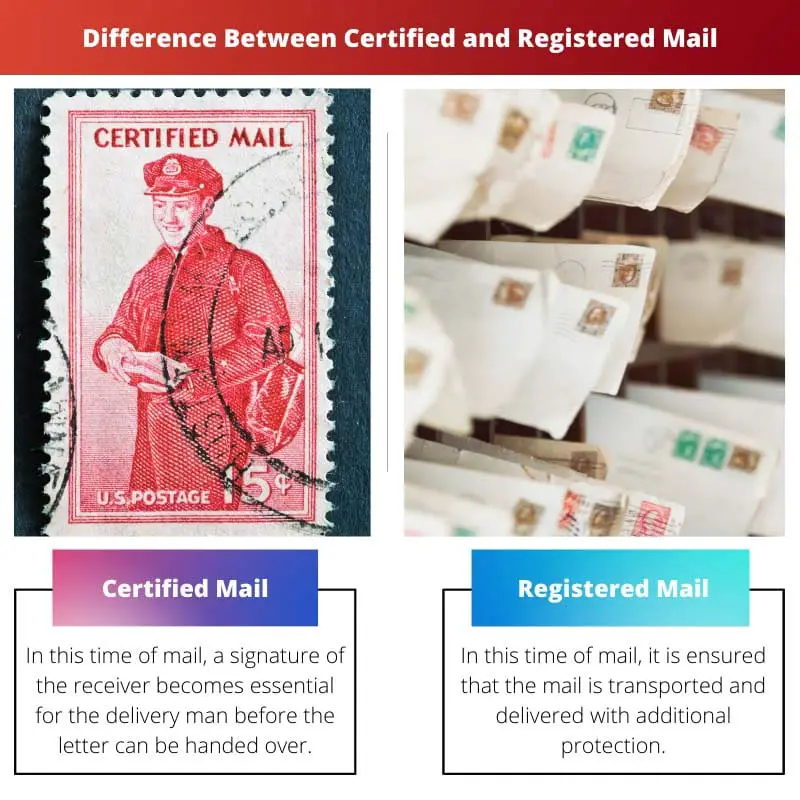Certified mail is one of the postal services given to the customer. The sender receives a certificate that the mail has been delivered to the specified person/authority with signature proof.
It also allows the sender to track the item’s safety using the 20-digit tracking code provided upon the mailing of the item.
This code enables the sender to follow each movement of the parcel.
The proof of receipt is kept with the postal office for almost two years in case the sender loses the certificate issued to them in the first place.
Registered mail comes into play when the item mailed is of high value and requires additional protection.
It is a postal service that aims to prioritize the safety of the item being sent.
For this purpose, these mail items are kept locked in safety boxes. The sender can track these items using the 13-digit tracking code provided when mailing the item.
Registered mail provides additional services compared to certified mail, such as a chain of custody sent to the sender of the mailed item.
Key Takeaways
- Certified mail is a service provided by the postal system that offers proof of mailing and delivery confirmation. In contrast, registered mail is a more secure service that provides tracking, insurance, and a chain of custody for valuable or sensitive items.
- Certified mail is suitable for important documents or items requiring proof of delivery. In contrast, registered mail is designed for high-value or confidential items that require additional security and protection during transit.
- Both certified and registered mail provides additional safeguards compared to regular mail services. Still, certified mail focuses on delivery confirmation, while registered mail offers enhanced security, tracking, and insurance options.
Certified vs Registered Mail
Certified Mail is a service offered by postal services, including the United States Postal Service (USPS), that provides a sender with proof of mailing and delivery of important documents or packages. Registered Mail is a secure postal service offered by many postal administrations around the world.

Comparison Table
| Parameter of Comparison | Certified Mail | Registered Mail |
|---|---|---|
| Meaning | In this time of mail, the receiver’s signature becomes essential for the delivery man before the letter can be handed over. | In this time of mail, it is ensured that the mail is transported and delivered with additional protection. |
| Focus | It is focused on delivering the mail to the right person with proof. | It is focused on delivering the mail while maintaining safety. |
| Code | It has a 20-digit tracking code. | It has a 13-digit tracking code. |
| Cost | It is an economical method of mailing items | It is costlier in comparison to certified mail. |
| Item handling | The mail is treated like ordinary mail. | The primary item is kept safe in locked boxes. |
| Suitability | It is suitable when proof of delivery is essential. | It is suitable when mailing high-value items. |
| Service | It only provides a return receipt and returns receipt after mailing. | It provides insurance, restricted delivery, return receipt after mailing, and return receipts. |
What is Certified Mail?
Certified mail came into existence in 1755. It was an addon to the Registered Mail system. It is focused on ensuring that the package is delivered to the person/authority and the proof is collected at delivery time.
Thus, certified mail gives more attention to the delivery of the letter. These are sent along with regular mail.
Each certified mail is assigned a unique tracking number, which is around 20 digits long and enables the sender to get a view of the package status.
These mails are not insured. For the insurance of certified mail, the sender has to pay an additional amount of money.
The same is true if the sender wants a return receipt.
These mails resort to government and business mail. If the receiver refuses that they did not receive the mail, the proof of delivery makes them liable.
This domestic mail service has multiple delivery options such as certified mail, certified mail with return receipt, certified mail with electronic return receipt, certified mail with return receipt and restricted delivery, and return receipt after mailing service.
This service sends court documents, tax audit notifications, etc.
In short, it comes handy when the mail includes documents that must be legally recognized.

What is Registered Mail?
Registered mail is the postal service that is a costlier mail method than the regular one. This is because it ensures the safety of the item being mailed.
This service provided by postal offices allows the sender to track the mail at every step, using the unique 13-digit code assigned to each mail.
This helps the person ensure the package was safely delivered to the recipient. It started in the mid-1500s in London.
These emails are not shipped with regular mail. The items of these mails are kept secured in locked boxes, and they arrive later than ordinary mails.
Usually, 10-14 days is the minimum delivery period. Registered mail provides the sender with a lot of benefits and facilities.
Some of them are proof of mailing, location tracking, proof of delivery, prioritized delivery, recordkeeping, protection against loss or theft, etc.
Registered mail can also provide proof of delivery upon request like certified mail. It offers services such as a chain of custody, returns receipt, and restricted delivery.
The restricted delivery of registered mail refers to the condition that the delivery will only occur when the addressee or the authority accepts the delivery. It prevents the misuse of the mail.
Registered mail opts for mailing valuables such as essential letters etc.

Main Differences Between Certified and Registered Mail
- Certified mail is the postal service where the delivery person must take the recipient’s signature. On the other hand, registered mail is the postal service that provides a complete chain of custody and additional security to the item being mailed.
- Certified mail has a unique tracking code of 20 digits, whereas Registered Mail’s tracking code is only 13 digits.
- Certified mail focuses on ensuring delivery and proof of the same, whereas registered mail focuses on keeping the item being mailed safely.
- Registered mail is costlier than certified mail.
- Certified mail is shipped with regular mail, whereas registered mail is shipped differently.


This article provides an in-depth comparison of certified and registered mail, offering valuable insights into their differences and their specific uses. It’s a helpful guide for anyone looking to make an informed decision about which mail service to use.
I completely agree, Sebastian. The article clearly explains the unique features of each mail service and their suitability for different types of mail. It’s a very informative read.
I found the comparison table to be particularly useful. It clearly outlines the distinctions between certified and registered mail, making it easier to understand their specific purposes.
The article effectively highlights the specific use cases for certified and registered mail, shedding light on their distinct functionalities. It’s a well-structured and informative piece.
I couldn’t agree more, Jessica. The article serves as a valuable resource for individuals seeking clarity on when to opt for certified or registered mail based on their unique needs.
The article effectively differentiates between certified and registered mail, offering readers a clear understanding of their respective advantages and targeted use cases. Well-structured and informative content.
It’s refreshing to come across an article that educates readers on the nuances of certified and registered mail in such a comprehensive manner. Excellent work.
I share the same view, Gary. The clarity provided in this article makes it a valuable resource for individuals navigating the complexities of postal mail services.
The article effectively distinguishes between certified and registered mail, offering readers a nuanced understanding of their specific applications. It’s a well-researched and informative piece.
I found the article to be an illuminating exploration of certified and registered mail, providing a comprehensive breakdown of their unique characteristics. Informative and well-executed content.
I agree, Kelly. The detailed comparison between certified and registered mail makes this article an insightful resource for individuals navigating postal service options.
The article provides a comprehensive overview of certified and registered mail, highlighting their distinct features and functionalities. It’s a valuable resource for anyone seeking clarity on these mail services.
I couldn’t agree more, James. This article serves as an indispensable guide for individuals navigating the complexities of postal mail options.
The detailed comparison table presents a clear breakdown of the differences between certified and registered mail. It’s a useful reference for anyone seeking a quick overview of their features and benefits.
The comparison table is a standout feature of the article, providing a concise yet comprehensive overview of the unique attributes of certified and registered mail.
I found the comparison table to be an excellent summary of the key distinctions between these two mail services. It’s a great addition to the article’s content.
The historical context provided for certified and registered mail adds depth to the article’s content. Understanding the origins of these services helps contextualize their significance in modern postal systems.
I agree, Ffox. Exploring the historical evolution of these mail services enriches the reader’s knowledge and appreciation for their role in the broader context of postal systems.
While the article is informative, it doesn’t delve into the potential drawbacks or limitations of certified and registered mail. A more balanced approach would have added additional value to the content.
I see your point, Ella. Providing a comprehensive overview, including the potential downsides, would have given readers a more complete understanding of these mail services.
It’s essential to consider the limitations of these services, and I believe the article missed an opportunity to address that aspect in detail.
The historical background offered for certified and registered mail enriches the article’s depth of content, providing readers with a broader perspective on the evolution of these postal services.
I share the same sentiment, Johnson. Understanding the historical context enhances the value of the article and its relevance to the broader history of postal systems.
While the article covers the basics of certified and registered mail, it lacks a critical analysis of emerging trends or potential innovations in postal services. A forward-looking perspective would have added depth to the content.
The omission of insights into the future of postal services was a missed opportunity in an otherwise well-structured article. Future-oriented analysis would have enriched the content.
I agree, Alan. Considering the evolving landscape of postal services, a discussion on future developments would have enhanced the article’s relevance in a rapidly changing environment.